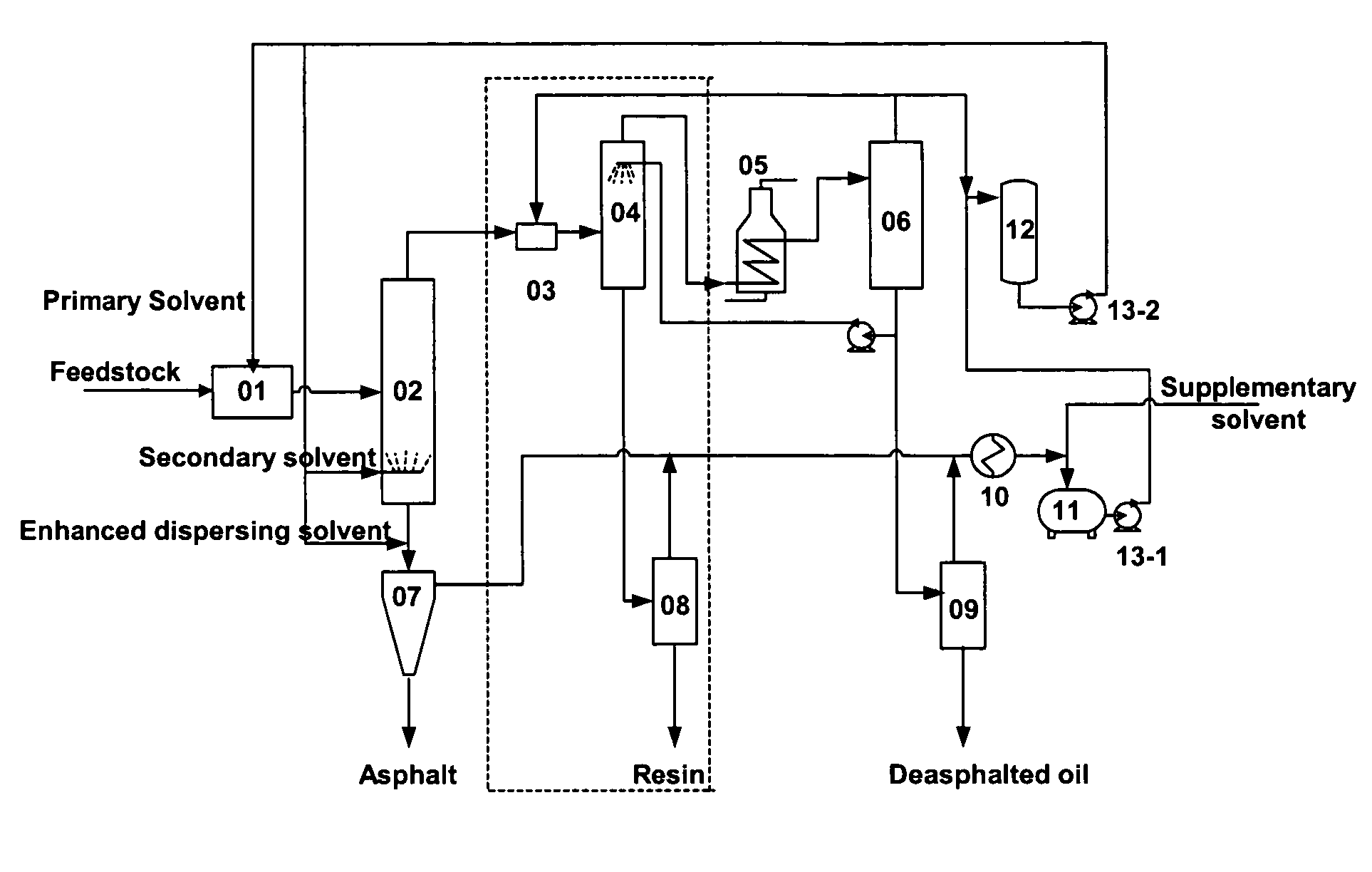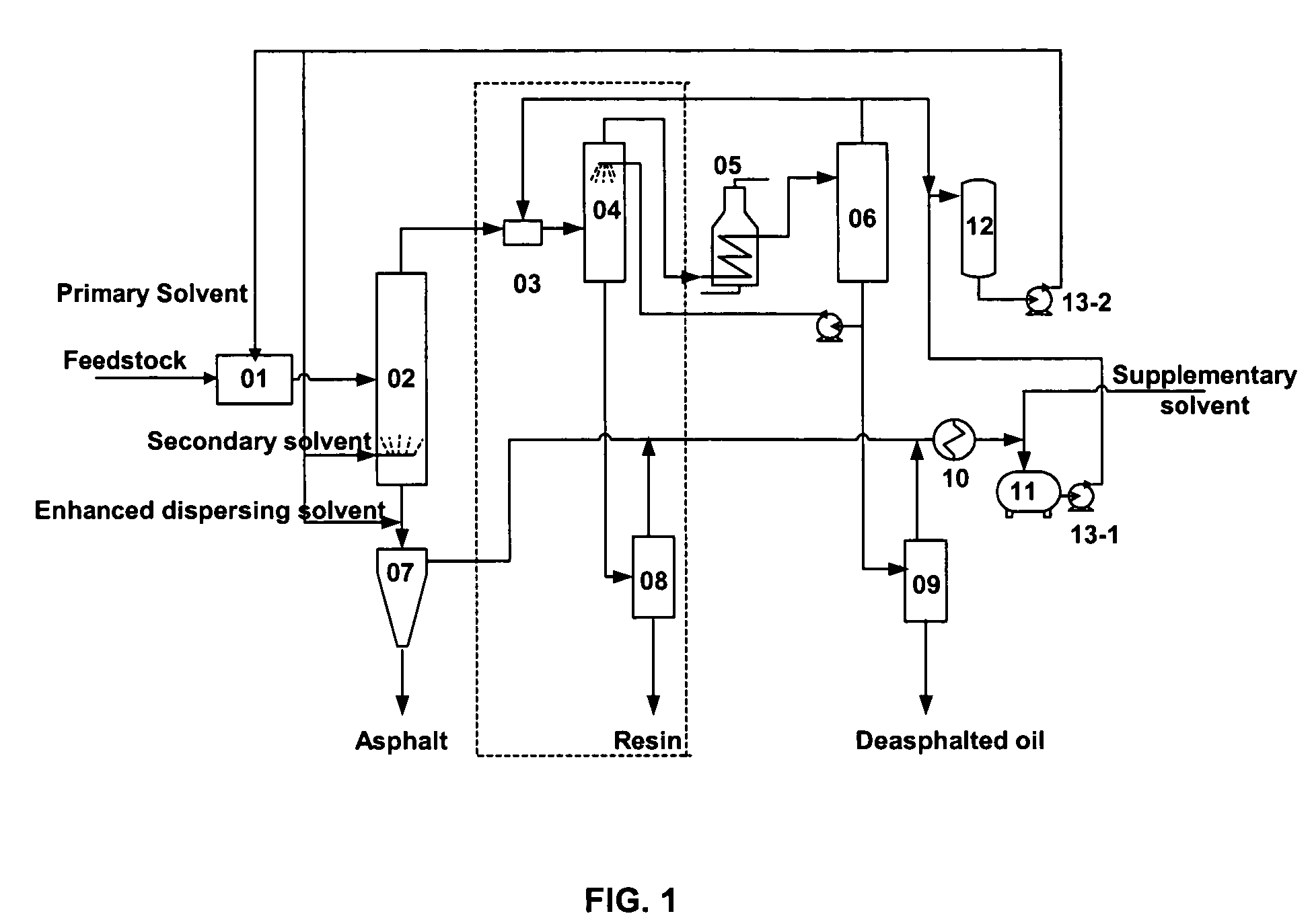Deep separation method and processing system for the separation of heavy oil through granulation of coupled post-extraction asphalt residue
a processing system and heavy oil technology, applied in separation processes, working up pitch/asphalt/bitumen by selective extraction, chemical/physical/physicochemical processes, etc., can solve the problems of limiting the yield of dao, still needs a complicated heat exchange system, and cannot achieve good dao quality, etc., to achieve the effect of eliminating the use of heating devices, and reducing the number of heating devices
- Summary
- Abstract
- Description
- Claims
- Application Information
AI Technical Summary
Benefits of technology
Problems solved by technology
Method used
Image
Examples
example 1
[0045]Deasphalting of vacuum residue (boiling point higher than 520° C.) from Shengli Oil Field of China was performed with pentane blended as solvent. Two-stage separation was employed and the vacuum residue was separated as DAO and solid asphalt powder.
[0046]The composition of the solvent was as follows:
[0047]
ComponentsisobutanebutanepentanehexaneComposition, mol %1.000.0578.0520.90Critical Temperature,135.0152.0196.6234.4° C.
[0048]The pseudo critical temperature for the blended solvent was 191.1° C.
[0049]Feedstock (flow rate at 100 kg / h) and the primary solvent (flow rate at 350 kg / h) were mixed in mixer 01 (i.e., primary solvent ratio 3.5) and the mixture entered extraction column 02 for the separation of DAO and the asphalt phase. Secondary solvent with a mass flow ratio of 0.8 was input from the lower part of the extraction column 02 for further extraction of the oil in the asphalt phase to improve the yield of DAO and to increase the softening point of the deoiled asphalt. Th...
example 2
[0055]Deasphalting of vacuum residue (boiling point>520° C.) from Shengli Oil Field of China was performed with pentane blended as solvent. The compositions of the solvent were the same as in Example 1. A three-stage separation process was employed and the vacuum residue was separated as DAO, resin and solid asphalt powder.
[0056]The feedstock (flow rate at 10 kg / h) and the primary solvent (flow rate at 35 kg / h) were mixed in mixer 01 (i.e., primary solvent to oil ratio 3.5:1) and the mixture entered extraction column 02 for the separation of DAO and the asphalt phase. Secondary solvent with a mass flow to oil ratio of 0.8:1 was input from the lower part of the extraction column for further extraction of the oil in the asphalt phase to improve the yield of DAO and the softening point of the deoiled asphalt. The extraction column was at 170° C. and 5 MPa.
[0057]The asphalt phase from extraction column 02 was mixed with enhanced dispersing solvent and the mixture was introduced into gas...
example 3
[0062]Atmospheric residue from Canadian Athabasca oil sand bitumen with a boiling point over 350° C. and a density of greater than 1.0 g / cm3 at 20° C. was obtained from a commercial oil sand plant. This is a heavy feedstock that is quite difficult to process. A two-stage extraction process was used as in Example 1 with pentane as the solvent. The flow rate of feedstock was 100 kg / h with a primary solvent to oil ratio of 3:1 and a secondary solvent to oil ratio of 0.5:1. The extraction column was at 160 C and 5 MPa. The softening point of the asphalt was 180° C.
[0063]The asphalt phase and the enhanced dispersing solvent were mixed with a solvent to asphalt mass flow ratio of 0.02:1. The mixture then entered gas-solid separator 07 and the asphalt and the solvent were separated at atmospheric pressure by rapid phase change. The asphalt particles were 300 μm in average diameter with residual solvent of 0.25 wt % of the mass of the asphalt particles.
[0064]The solvent density in the super...
PUM
| Property | Measurement | Unit |
|---|---|---|
| pressure | aaaaa | aaaaa |
| temperature | aaaaa | aaaaa |
| density | aaaaa | aaaaa |
Abstract
Description
Claims
Application Information
 Login to View More
Login to View More - R&D
- Intellectual Property
- Life Sciences
- Materials
- Tech Scout
- Unparalleled Data Quality
- Higher Quality Content
- 60% Fewer Hallucinations
Browse by: Latest US Patents, China's latest patents, Technical Efficacy Thesaurus, Application Domain, Technology Topic, Popular Technical Reports.
© 2025 PatSnap. All rights reserved.Legal|Privacy policy|Modern Slavery Act Transparency Statement|Sitemap|About US| Contact US: help@patsnap.com



